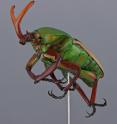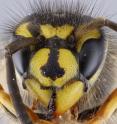Better focus at the micro world: A low-budget focus stacking system for mass digitization
A team of Belgian researchers constructed a focus stacking set-up made of consumer grade products with better end results than high-end solutions and this at only a tenth of the price of current existing systems. Because of the operational ease, speed and the low cost of the system, it is ideal for mass digitization programs involving type specimens. The study was published in the open-access journal ZooKeys. Enthusiasts or scientists, many struggle to take high quality pictures of the tiny animals of the micro world. When they eventually succeed in their effort, it is clear that rarely the entire subject is in focus.
However, a solution exists to overcome the problem of small focused area in macro photography: focus stacking. In this technique many pictures need to be shot with different focus ranges. The entire set of pictures will be glued together into one image with the entire subject in focus. This is nothing innovative, as the technique exists already for several years. Many microscope companies offer solutions to produce these sets of pictures of any subject at the other end of the lens. The downside is that these set-ups are only available at high prices.
The presented set-up by Jonathan Brecko working as a scientist for the Royal Institute of Natural Sciences (RBINS) and the Royal Museum of Central Africa (RMCA) (both Federal Belgian Institutes), produces the same or even better results than the high-end solutions tested in the manuscript. And this for only a fraction of the cost (8 to 10 times less).
The set-up is fairly easy to control and consists of consumer grade products, making it easy to replace when needed. The central idea of the set-up is to place both the subject and the light system within a simple kitchen closet.
Thanks to the low noise and high resolution of the 65 mm macro photo lens used for the project and the lighting system placed within the closet, it is fairly straightforward to produce high detailed quality pictures. Even specimens within alcohol pose no problems at all to be pictured.
This set-up can be an important tool to aid in digitization programs, because the highly detailed pictures can in some cases replace the need to ship or send very fragile specimens for study in all kinds of disciplines. At the moment the set-up is used in the digitization programs involving type specimens at RBINS and RMCA.
Source: Pensoft Publishers
Other sources
- Better focus at the micro world: A low-budget focus stacking system for mass digitizationfrom Science DailyWed, 17 Dec 2014, 22:31:44 UTC
- Better focus at the micro world: A low-budget focus stacking system for mass digitizationfrom PhysorgWed, 17 Dec 2014, 15:00:25 UTC

